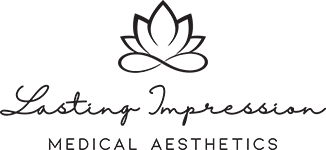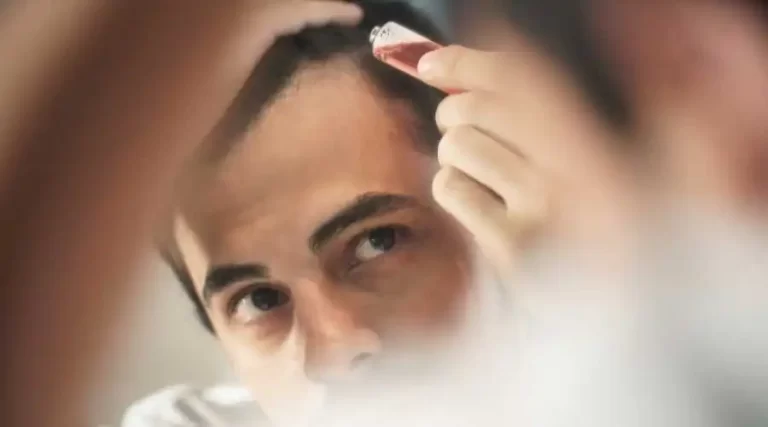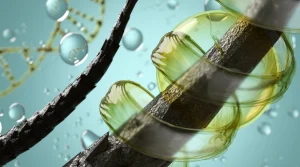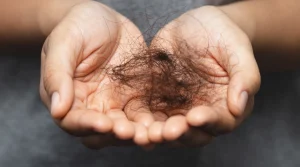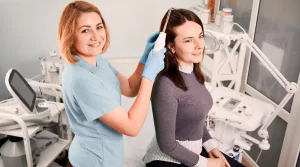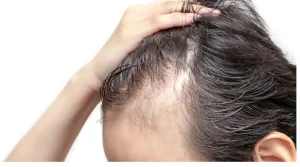We’re not trying to scare you, but if you’re reading this, you’ll likely lose your hair at some point in your life. Maybe you have already, but this is entirely normal. It happens to a lot of people. Statistics show that around two-thirds of men aged 35 have noticed some relevant hair loss; that number increases to 85% by age 50, so you’re not alone in this.
Choosing how to deal with hair loss is a personal choice. It’s not wrong to get to the point and decide to shave your head. There’s also no shame in using hair loss treatments to stop or slow the loss. Which brings up another question: which product do you try?
There are a lot of snake oil salesmen in the world of hair loss treatments who only want your money and sell you things that don’t work. So, we asked Natalie Kash, MD, Barry Goldman, MD, and Dhaval Bhanusali, MD, all board-certified dermatologists, which products are worth your attention and money.
Why Does Hair Fall Out?
Before treating hair loss, you need to figure out why it’s happening. Natalie Kash, MD, says that genes and hormones mainly cause the usual male pattern of baldness (alopecia). A hormone called dihydrotestosterone (DHT) causes male baldness as it shortens the hair’s life cycle, which makes it shed and fall out more. Dr. Kash also says that more evidence suggests inflammation and oxidative stress can cause MPHL. MPHL is easy to spot because hair loss is usually concentrated in “certain parts of the scalp,” like the hairline, top of the head, and crown, she says, while hair loss is usually less noticeable on the lower part of the scalp and around the ears.
But other kinds of hair loss make things more complicated. Hair loss can be an aftereffect of stress and can cause surgery, or other problems inside the body, like thyroid problems or not getting enough vitamin D. Dermatologist Barry Goldman, MD, says that alopecia areata is caused when the body’s immune system attacks the hair follicles by mistake. It leads to smooth circles of hair loss on the scalp and sometimes in the beard area that can be pretty challenging to treat. If you don’t know what’s causing your hair to be thin, it’s best to see an expert figure out how to deal with it.
Tips for Choosing a Hair Loss Treatment
Review the Ingredients
Look for tried and true minoxidil if you want to spread your bets. Dr. Kash recommends products with 5% minoxidil, which is the most that can be bought without a prescription. She also says that, as long as all the products contain 5% minoxidil, there isn’t much difference in how well they work. Finasteride is the other FDA-approved drug. It is usually taken by mouth, so it is less likely to be in products you put on your skin. Other hair-healthy ingredients, like collagen and antioxidants found in supplements, can help, but they can’t take the place of these two.
Consider Your Type of Hair & Texture
According to Dr. Goldman, the good news is that “we haven’t seen a difference in how well it works for people with fine or coarse hair.” “More research needs to be done,” though. And medicines like minoxidil work on all hair types, but how you use them may differ. Dr. Kash says the most important rule of thumb is putting the products on the scalp and just on the hair shaft. She also says that if you have fine hair, you should put the product on at night, let it dry while you sleep, and then brush it. If you use it in the morning, it might make fine hair look greasy and heavy. Apply the product evenly and massage it into your scalp, especially if you have textured hair since products like minoxidil can leave textured hair dry.
Recommended Treatments
Below are the highly recommended hair regrowth products:
5% Minoxidil Foam by Rogaine
All of our experts agreed that 5% minoxidil is the best way to treat Male Pattern Hair Loss. It is FDA-approved and has been shown in clinical trials to stop hair loss and help hair grow back. Rogaine, the first treatment to use minoxidil, is still the most popular choice, especially since it’s purchasable in most drugstores. Dr. Kash says to pick up the foam because it’s easier to handle and less likely to get on your face (if it does, wash it off quickly to avoid weird hair patches). The solution has propylene glycol in it, but the foam doesn’t. It is because some people are allergic to propylene glycol.
Pill Finasteride by Hims
Finasteride and minoxidil are the other gold standard treatment for hair loss. Dr. Goldman says that finasteride can be “more effective” than minoxidil. He also says that it has been studied a lot, including studies that counted the number of hairs and studies that showed the increase in hair count lasted for two years. The bad thing is that you need a prescription to get it, and you should always use it under a doctor’s care because it can cause side effects like bloating, chills, and less sex drive, among other things. “Hims” is a brand that lets you talk to a doctor online and get finasteride delivered directly to your door.
Combined Minoxidil & Finasteride by Keeps
“Keeps” has what you need if you want to use both minoxidil and finasteride simultaneously. They sell both as a package, and you can add other products like shampoos that make your hair thicker or eliminate dandruff. They only sell hair loss medicines that the FDA has approved. They don’t sell snake oil, and you have to talk to a doctor before you can buy finasteride since it’s only available with a prescription. The only problem is that, for legal reasons, you might not be able to get a medical consultation in your state. If that’s the case, you’d only be able to buy minoxidil. Overall, the products are easy to use and even easier to get.
- Finasteride: $25/month
- Minoxidil: $10
- Doctor Consultation: First visit free. $5/visit after that.
Hair Regrowth Kit by MDHair
Think of your current lifestyle and how it affects your hair. Based on your answers, MDHair will put together a treatment kit for you with products made by dermatologists. They have a more well-rounded approach than similar companies because they look at your genes and other things in your life that could be causing hair loss. There is the classic minoxidil serum, but medicated shampoos and supplements with natural ingredients help hair grow. When used together, they can treat more causes of hair loss than a single product can. You can also buy a specific product separately or add it to your current kit:
- Minoxidil Serum: $24
- Haircare Shampoo: $22
- Regrowth Supplements: $42
Men’s Hair Growth Supplement by Viviscal
Hair-friendly components, including vitamin C, zinc, and flax seed, are abundant in Viviscal, which aids in maintaining a healthy cycle for the hair. To assist in growth, take a tablet each morning and each night. Doctor Dhaval Bhanusali adds that supplements like these “may be a good supporting player,” but they can work better with effective therapies.
Laser Hair Treatment by iRestore
Dr. Kash prefers a helmet because it’s easier to use than other equipment like combs, which can be cumbersome. Place it on your head and turn it on. Like other LED gadgets, the red lights inside the cap encourage blood flow to the scalp, reducing inflammation, which is beneficial to hair development. Dr. Kash recommends this FDA-cleared cap since it is of excellent quality at a reasonable cost (compared to other similar models). To get the best benefits, her one piece of advice is to commit daily to utilizing it.
Are the Treatments Worth the Money?
Experts suggest using the tried-and-true, FDA-approved ingredients minoxidil and finasteride. These ingredients have been shown to help control MPHL through years of research. These are the only two ingredients that the FDA has approved for treating hair loss. That doesn’t mean other treatments, like supplements, natural remedies, and gadgets won’t work.
It just means that the science behind them isn’t as strong (or doesn’t exist). There’s also something to be said for using more than one method, like minoxidil and a supplement. But if you try something and your hair loss doesn’t improve or worsen, you should see a dermatologist or a hair loss specialist.
